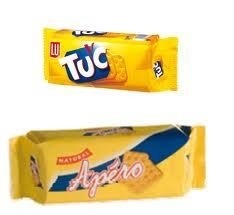

Food for thought: protection and design of foodstuffs and packaging
Types of trademark
Trademarks for foodstuffs are registered in different ways. Although many manufacturers have registered word marks, the visual aspect of a mark also plays an important role. Since consumers often encounter products in the supermarket, a product must immediately distinguish itself from all the other products.
Therefore, the Trademark Register is full of registrations of logos, packaging and colours. With these registrations manufacturers hope to prevent competitors from taking advantage of the recognisability and appearance of packaging. It is also possible to register the shape of a product (eg, Wokkel crisps), but this is not easy to achieve. As consumers are not expected to recognise a product immediately by its shape, a shape trademark must be radically different from usual shapes in the market. Coca-Cola recently suffered an important loss in relation to this requirement. The European Court of Justice ruled that Coca-Cola’s plastic bottle was not sufficiently different from bottles already on the market. Further, a shape may not have a technical nature. At present, the Kit Kat chocolate bar is subject to legal debate. According to the UK Intellectual Property Office, the fact that the bar can easily be broken into smaller bars means that the mark’s shape is necessary to produce a technical result. The UK courts must now rule on this issue.
Extent of protection
A trademark registration is relevant only when a competitor copies the trademark in such a way that there is a likelihood of confusion. In terms of consumers, the overall impression of both products plays a decisive role. This creates an interesting twist for supermarket products. The supermarket is not a place where people make considered purchases; many people choose a product based on just a quick glance over the shelf. Therefore, it is easier to make a mistake when buying something in the supermarket than in, for example, a car showroom. The rapid decisions made by consumers in the supermarket mean that the likelihood of confusion is assumed quickly. Similar coloured packaging can be enough.
For example, in a case regarding Tuc and Apéro biscuits (shown below), the Court of The Hague held that the yellow background, white letters (with red outline) and blue areas meant that there was a likelihood of confusion between the two products.

Consumers becoming more critical
There is an increasing trend whereby consumers are looking more critically at foodstuffs. Several certification marks have been introduced aimed at guaranteeing the quality of foodstuffs.
This development is to be welcomed because, in most cases, certification marks guarantee better health, a better environment or better animal welfare. Unfortunately, strict controls are necessary in order to ensure compliance with the rules for the use of certification marks. The misuse of certification marks can mislead consumers or, even worse, pose risks to consumer health.
It is not only the use of certification marks that requires monitoring. The production and processing of foodstuffs must also be controlled. Recent scandals have involved horsemeat, smoked salmon and powdered for babies.
Information on label
When purchasing products in the supermarket, consumers largely rely on the information presented on the label. It is therefore important that this information is accurate and complete and, more importantly, that it is not misleading. To ensure this, various rules apply to packaging information.
For example, there are rules regarding the use of:
- a geographical location (eg, 'Greek yoghurt’ versus ‘Greek-style yoghurt’);
- certain health claims (eg, ‘sugar-free’ or ‘low salt’); and
- food information (eg, calories, protein or fat).
Some manufacturers have complained that this gives them little space to make their labels attractive, but consumers increasingly attach value to this information.
The supermarket jungle
The weekly trawl through the supermarket involves more than it might appear. Consumers are tempted from all sides to buy different products. At the same time, manufacturers are trying to carve out and defend their own places on the shelves and in consumer minds. However, the fight for consumer attention is also conducted through quality communications and certification marks on the packaging. National legislation and regulations should help consumers and protect them from confusion and misrepresented products. The supermarket is in fact a regulated jungle.

